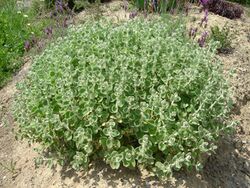Biology:Ballota pseudodictamnus
| Ballota pseudodictamnus | |
|---|---|

| |
| Scientific classification | |
| Kingdom: | Plantae |
| Clade: | Tracheophytes |
| Clade: | Angiosperms |
| Clade: | Eudicots |
| Clade: | Asterids |
| Order: | Lamiales |
| Family: | Lamiaceae |
| Genus: | Ballota |
| Species: | B. pseudodictamnus
|
| Binomial name | |
| Ballota pseudodictamnus | |
Ballota pseudodictamnus, the false dittany,[2] is a species of flowering plant in the mint family Lamiaceae, native to the southern Aegean region.
Description
A low mound-forming evergreen shrub growing to 50 centimetres (20 in) tall and wide, it bears almost circular, dished, silver-green leaves with a soft felted texture; and masses of pink flowers (which are mostly hidden by the leaves) in late spring and early summer.[3]
It tolerates temperatures as low as −10 °C (14 °F), but requires very dry conditions and sharp drainage in full sun.
The Latin specific epithet pseudodictamnus means "false dittany".[4] In this case, the resemblance is to the classical dittany of Crete, Origanum dictamnus, not to the much more distantly related genus Dictamnus in the family Rutaceae.
In cultivation in the UK, this plant has gained the Royal Horticultural Society's Award of Garden Merit.[2]
Distribution
Ballota pseudodictamnus is native to dry Mediterranean regions in Europe and western Asia,[5][6] including Greece (South Aegean), Egypt, Libya and Turkey. It is also an introduced species[5] in the British Isles and Italy (Sicily).
Names
Several common names are attached to this plant, including false dittany, false divinity, and Greek horehound.[7]
Synonyms
References
- ↑ "The Plant List - Ballota pseudodictamnus". http://www.theplantlist.org/tpl1.1/record/kew-19656.
- ↑ 2.0 2.1 "RHS Plantfinder - Ballota pseudodictamnus". Royal Horticultural Society. 2017. https://www.rhs.org.uk/Plants/1966/i-Ballota-pseudodictamnus-i/Details.
- ↑ "Ballota pseudodictamnus". perennials.com. http://www.perennials.com/plants/ballota-pseudodictamnus.html.
- ↑ Harrison, Lorraine (2012). RHS Latin for Gardeners. United Kingdom: Mitchell Beazley. ISBN 184533731X.
- ↑ 5.0 5.1 5.2 "Ballota pseudodictamnus (L.) Benth. | Plants of the World Online | Kew Science". http://powo.science.kew.org/taxon/urn:lsid:ipni.org:names:444985-1.
- ↑ Springer., Ogden, Lauren (2000). Passionate gardening : good advice for challenging climates. Proctor, Rob.. Golden, Colo.: Fulcrum Pub. ISBN 1555913482. OCLC 42580378. https://archive.org/details/passionategarden0000ogde.
- ↑ "Ballota pseudodictamnus (BLLPS)[Overview| EPPO Global Database"] (in en). https://gd.eppo.int/taxon/BLLPS.
- ↑ 8.0 8.1 "World Checklist of Selected Plant Families: Royal Botanic Gardens, Kew" (in en-GB). http://wcsp.science.kew.org/synonomy.do?name_id=19656.
Wikidata ☰ Q15345437 entry


